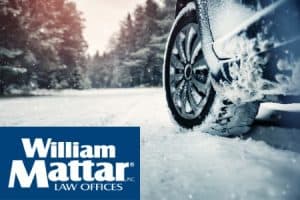Winter Weather Driving Safety
Winter weather is a fact of life in New York State, and driving in winter conditions is often a necessity. Given the risks associated with driving in snow, ice, and sleet, motor vehicle accidents happen often throughout the winter months. In fact, an estimated 17 percent of motor vehicle crashes occur in wintry conditions. When a winter weather driving crash happens, the effects can be devastating for all involved. Many victims suffer serious injuries that can turn their lives upside down.
If you’ve been seriously injured in a winter weather driving incident, contact William Mattar law offices. Our experienced personal injury attorneys work with accident victims every day to get them the compensation they need. We know you may be struggling, and we want to help ease that burden. To speak to one of our attorneys or schedule a free initial consultation today, call us at (844) 444-4444.
THE RISKS OF DRIVING IN WINTER WEATHER
 There are various risks of driving in winter weather that contribute to serious accidents on the road. These dangers include, but are not limited to:
There are various risks of driving in winter weather that contribute to serious accidents on the road. These dangers include, but are not limited to:
- “Black ice”: One of the most perilous hazardous in winter weather is black ice. This type of ice is transparent, and often very hard to spot on the surface of pavement. Black ice can cause vehicles to swerve and hydroplane off the road or into other objects, resulting in a tragic accident.
- Low visibility: When precipitation, such as rain, snow, or hail falls, it can make it difficult to see through a windshield while driving. Heavy snow or blizzard-like conditions, and other factors such as fog, are especially dangerous to drivers. In bad weather conditions, a motorist’s vision may become impaired, increasing the risk of a potential motor vehicle crash.
- Fast braking: Quick and sudden driving decisions in winter weather can put you at risk on the roadways. Fast braking can cause a car to lose control when on a slippery surface.
- Loss of traction: There are multiple ways that a vehicle can lose traction in winter weather conditions, including driving over ice, up an incline, or accelerating. A loss of traction is caused by friction between the road and a vehicle’s tires. It can also result in difficulty steering.
- Vehicle maintenance issues: Cold weather can damage a vehicle through corrosion (leading to rust) and freezing temperatures. Belts and hoses, battery, brakes, fluids, and tire pressure can be affected by winter weather if they are not properly maintained.
TIPS FOR SAFE WINTER DRIVING
Wintry roads can be hazardous, but taking a few simple steps can help you reach your destination safely. American Automobile Association (AAA) recommends taking the following winter driving safety precautions:
- Stay home. Only go out if necessary. Even if you can drive well in bad weather, it’s better to avoid taking unnecessary risks by venturing out.
- Drive slowly. Always adjust your speed down to account for lower traction when driving on snow or ice.
- Accelerate and decelerate slowly. Apply the gas slowly to regain traction and avoid skids. Don’t try to get moving in a hurry and take time to slow down for a stoplight. Remember: It takes longer to slow down on icy roads.
- Increase your following distance to five to six seconds. This increased margin of safety will provide the longer distance needed if you have to stop.
- Know your brakes. Whether you have antilock brakes or not, keep the heel of your foot on the floor and use the ball of your foot to apply firm, steady pressure on the brake pedal.
- Don’t stop if you can avoid it. There’s a big difference in the amount of inertia it takes to start moving from a full stop versus how much it takes to get moving while still rolling. If you can slow down enough to keep rolling until a traffic light changes, do it.
- Don’t power up hills. Applying extra gas on snow-covered roads will just make your wheels spin. Try to get a little inertia going before you reach the hill and let that inertia carry you to the top. As you reach the crest of the hill, reduce your speed and proceed downhill slowly.
- Don’t stop going up a hill. There’s nothing worse than trying to get moving up a hill on an icy road. Get some inertia going on a flat roadway before you take on the hill.
WE’RE HERE TO HELP
We hope these safety tips help you stay safe while driving in wintry conditions, but if you get in an accident, our Buffalo car accident lawyers are here to help. William Mattar Law Offices focuses on motor vehicle crashes with injuries, and our staff is available 24/7 to assist you. Call us immediately at (844) 444-4444 or complete our free initial consultation form, and we’ll do everything we can to help you get back on your feet.

















